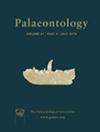Priapulid neoichnology, ecosystem engineering, and the Ediacaran–Cambrian transition
IF 2.3
2区 地球科学
Q1 PALEONTOLOGY
引用次数: 0
Abstract
The evolutionary rise of powerful new ecosystem engineering impacts is thought to have played an important role in driving waves of biospheric change across the Ediacaran–Cambrian transition (ECT;普氏新生物、生态系统工程和埃迪卡拉-寒武纪过渡期
在埃迪卡拉-寒武纪过渡期(ECT;约 574-538 Ma),新的强大的生态系统工程影响被认为在推动生物圈变化浪潮中发挥了重要作用。其中被引用最多的是生物扰动(生物驱动的沉积物扰动),因为这些活动已被证明会对下游地球生物学产生重要影响。在这方面,普氏蠕虫至关重要;被认为是普氏蠕虫类动物留下的微量化石现已被确认为出现在寒武纪底部前不久,并代表了一些最早的海床穿透性生物扰动实例。因此,了解priapulids对生态系统工程的影响可能是重建ECT驱动因素的关键。然而,priapulids在现代底栖生态系统中非常罕见,因此人们对它们的穴居行为和影响知之甚少。在此,我们介绍了新昆虫学实验的早期结果,这些实验的重点是了解犁头虫对生态系统工程的影响。我们首次观察到各种新的穴居行为(包括形成相连的穴居网络和较长的穴居时间),这表明该类蠕虫对生态系统工程的影响比以前想象的要大。最后,我们确定了这些结果可能有助于我们了解整个埃迪卡拉纪的痕量制造者,以及它们在塑造最近的埃迪卡拉纪和最早的寒武纪生物圈中可能发挥的作用。
本文章由计算机程序翻译,如有差异,请以英文原文为准。
求助全文
约1分钟内获得全文
求助全文
来源期刊

Palaeontology
地学-古生物学
CiteScore
5.60
自引率
3.80%
发文量
43
审稿时长
6 months
期刊介绍:
Palaeontology publishes a wide variety of papers on palaeontological topics covering:
palaeozoology
palaeobotany
systematic studies
palaeoecology
micropalaeontology
palaeobiogeography
functional morphology
stratigraphy
taxonomy
taphonomy
palaeoenvironmental reconstruction
palaeoclimate analysis and biomineralization studies.
 求助内容:
求助内容: 应助结果提醒方式:
应助结果提醒方式:


